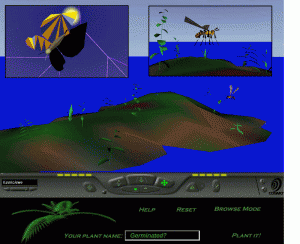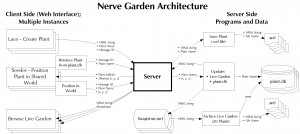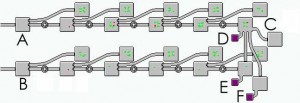Gianna Maria Gatti:
(translated from the Italian by Alan N. Shapiro)
(this chapter of The Techological Herbarium was substantially rewritten for the English edition by Alan N. Shapiro, with the approval of Gianna Maria Gatti)
All images © Copyright Bruce Damer, embedded here with the permission of the artist.
Nerve Garden is a three-dimensional virtual world accessible on the Internet, a “Public Terrarium in Cyberspace,” according to the definition of its authors, where the users of the Net can sow and witness the growth of virtual plants.
Launched on line in August 1997 in Los Angeles on the occasion of the annual SIGGRAPH conference, this work represents the first work produced within a larger research project started in 1996 called Biota.org (the Digital Biology Project). A key goal of Biota.org was to combine Artificial Life that simulates the dynamics of biology and evolutionary theory with informatic technologies which restore a three-dimensional vision of sceneries in the World Wide Web, for the purpose of creating original ecosystems useable by the vast Internet public.
The organizer of Biota.org is the artist of Canadian origin Bruce Damer, who in 1995 founded two important organizations with headquarters in California, DigitalSpace Corporation and the Contact Consortium, both of them dedicated to the proliferation of virtual worlds and virtual communities on the Internet, related to social and scientific progress. DigitalSpace is a research and development firm that is involved in extremely advanced projects of international importance: for example, it supports NASA by producing 3D design simulations of the habitat of Planet Mars, and previously worked with Adobe Systems, Inc. in the development of the Adobe Atmosphere software. The Contact Consortium acts, on the contrary, on the level of cultural promotion, organizing interdisciplinary conferences, often in collaboration with universities [including the Avatars series from 1996 to 2004 — Alan N. Shapiro]. It is organized as a series of special interest groups (SIGS) such as Biota.org, which is oriented to the study and conception of living systems from the natural toward the artificial. Other early Consortium SIGS included Sherwood Forest Towne, one of the first experiments in building a three-dimensional virtual city in cyberspace, going back to early 1996. Taking inspiration from the founding of new settlements within natural areas, with explicit reference to the English medieval historical experience, the city of Sherwood, surrounded by mountains and immersed in green, evolves in phases: it is the actions of the users [moving through it in their avatars – ANS] that completes it little by little, engaged as builders gradually achieving an emerging design. Defined as a real city both by the presence of a shared commons and public buildings characteristic of every urban context, and by the roles of its visitors relating to social organization, it can even be subjected to acts of vandalism in so far as it is freely accessible, lacking in prohibitions. The only requirement is familiarity with the AlphaWorld software environment used.
To start an experiment in learning in virtual worlds, the Contact Consortium [member Stuart Gold — ANS] instituted, in a further project, TheU, an architecture competition to build a virtual university equipped with classrooms and structured like an American campus. Online teaching maintains and strengthens the sense of sharing and the collective approach of traditional scholastic learning.
Sherwood Forest (1996), The U (1996), Nerve Garden (1997) and Vlearn3D (1998-2002) together provide a plurality of perspectives that constitute that new vision of the communicative space of shared virtual worlds on the Internet pursued by Damer.
Let us return to the summer of 1994 to the origins of Biota.org. Having traveled to the Santa Fe Institute to participate in a debate with Chris Langton and the students of his team, Damer witnessed the installation of the first Mosaic Web browser, and attended the presentation of a work by Karl Sims centered on Artificial Life [movie animations of evolving virtual creatures — ANS]. Damer foresaw the coming of virtual environments on the Internet where hundreds of users would experience the paradigms of biology applied to artificial ecosystems and Karl Sims’ form of creatures comprised of geometric solids in continuous evolution. The following year, during the “Fourth Foresight Conference on Molecular Nanotechnology” in Palo Alto, California, Damer was demonstrating his Nerves finite state machine language and met developer Todd Goldenbaum, who on that occasion gave him an early demonstration of VRML (Virtual Reality Modeling Language). VRML was then opening up a whole series of opportunities for creativity for programmers and artists, which promised a revolutionary new way of conceiving and modeling living virtual space, for all to share. After further examination of the possibilities offered by this new programming language and its use in the field of Artificial Life, Damer and Goldenbaum decided to form a working group called Biota.org.
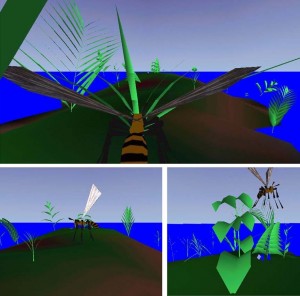
Lace germinator applet in action allowing users to extrude virtual plants from L-System starter “seeds”
It is in this climate of exchange and stimuli that Nerve Garden takes shape, not as a separate work, or as the fruit of the poetry of a single artist, but as a work in progress developed by a diverse group of contributors with the aim of experimenting with and testing the most innovative technologies by relating them to other fields of knowledge: “We hope that Nerve Garden will serve as a powerful demonstration of the use of VRML 2.0 in science and education. With compelling scenes with low polygon count, interactivity, natural metaphors accessible to a wide audience, and the ease of propagating gardens and new plant forms, we hope that Nerve Garden will also be a truly appropriate and refreshing new use of the Internet.”
By 1997, VRML makes it possible to create and share three-dimensional virtual worlds on the Web. Scenes could be enriched with colors and textures, light sources, and sounds, and supporting object movement and degree of interactivity. Based on programmed instructions contained in script files – to which one can add graphic files and hypertext links – VRML offered the advantage of using a standard format viewable on any platform (Windows, Mac, Linux…), guaranteeing the widest accessibility to every type of user. Version 2.0, used in Nerve Garden, also made it possible to associate behaviors with objects, thanks to the implementation of a link with a more complete programming language, Java. [VRML describes the environment of the virtual world, and Java describes behaviors within those environments — ANS].
Stylized islands textured with soft green and brown surfaces, distinguishing ground from meadow spaces, surrounded by a uniformly blue expanse of sea, compose the graphic scenery of Nerve Garden. A natural landscape bare of detail both enhances its own artificiality while at the same time tempting the visitor to initiate an informatic cultivation. It is against the backdrop of these digital terraria that the actors cultivate a drama of life, becoming the cyber-gardeners of the Net. VRML, Java, and the mathematics of L-Systems, neural nets – hence the title “Nerve” – the World Wide Web, the mouse, and keyboard are the specific tools used to activate it.
Let us now take a tour of the user’s experience of Nerve Garden. In the first version, a special interface, the “Lace Germinator Java,” welcomes the users who access the website of the installation, and guides them to the choice of [L-System algorithmic – ANS] seeds and to the [extruding through the Lace applet] of their online personal three-dimensional plant. The user, by using the mouse a series of controls, selects the shoot that he prefers from several botanical analogues, and establishes the parameters of morphogenesis and evolution that characterize its future growth on the island; he can maintain its adherence to a real natural model or else confer on it random qualities so as to make it gradually more unusual: unlimited are the possibilities of acting on the appearance of this virtual vegetable and of creating a personalized plant based on the taste of each user.
To distinguish this individuality, a name is given to the version that the user has been cultivating, the final step in the composition of that patrimony of data that accompanies the small plant in each successive stage [the user selects a gardening tool, akin to a synthetic spade — ANS] The task of assigning to it the portion of earth on one of the islands where it will grow and can be seen by all is the responsibility of the Java application “Nerve Server,” which marks it with a red sign in order that the user, via the mouse, can emplace his plant.
The life of the plant can thus make a start in real time within the virtual scenegraph “Seeder Garden,” forming next to the others the original and variegated vegetation of the environment.
At any moment the user can connect up to visualize the progress of the garden through some panoramic windows, and also by using mobile viewpoints represented by animated models of flying insects, like bees, hornets and butterflies, always at one’s disposal, to make a touristic trip around the island. By positioning himself virtually on their back, the user enjoys an aerial perspective that helps to locate the plant. The atmosphere is enlivened with the introduction of mysterious noises and with the breaking out of bolts of lightning which flash across the sky above the islands accompanied by thunder, and other supplementary effects obtained algorithmically.
During the activation of Nerve Garden at the 1997 SIGGRAPH [at the ‘Electric Garden’ new technology exhibit — ANS], one of three workstations set up for the interaction offered to the user a more involving sensorial experience: moving a mouse to germinate a virtual plant within a sandbox, and seeing on a large screen representing the three-dimensional island the effects corresponding to his moves, the user had the tactile impresssion of really sowing in the virtual ground, and the sense that they might control in real time the subsequent growth of the plant. Offering to the visitors a more physical approach to this new form of cultivation, Damer and the other authors wanted to establish a stronger link between people and the cyber-garden to arouse in them the desire to follow its developments, by connecting with the site of the island from their own homes after SIGGRAPH ended. The artists’ intention was to stimulate a feeling of sociality in the sharing of a single space, but above all to stimulate an emotional response to what was generated, to impart the sense that they had helped to realize a living organism. To this end, the vegetation production created at SIGGRAPH is classified and marked out so that the interested user can easily trace his creation in the next online version of the work. This would be the concretization of the objective that Damer’s group established in advance: “We will give participants the experience of sowing seeds in Cyberspace. Participants may come away from the SIGGRAPH Electric Garden proud of their petunias or unnerved by the realization that life may find a way into digital space.”
An Artificial Life naturally founded on genetic algorithms and neural nets; on the former is based the modelization and generative growth of the plants in Nerve Garden, coded strings of instructions necessary to define the characteristics of the structure and behavior of the organism, allowing in addition a certain margin of chance.
Damer and his collaborators have adopted the L-System of Lindenmayer, Pursinkiewicz and Mech, drawing on their research on the interaction between virtual plant models and artificial environments. L-Systems use string rewriting rules which simulate and calculate biological processes in the concatenation of polygonal modules, shaping eerily realistic plant models. L-Systems can manifest a likeness to what is present in nature or completely fanciful forms. They can express heterogenous and complex plant forms including fluorescences (flowers), as intended by Nerve Garden.
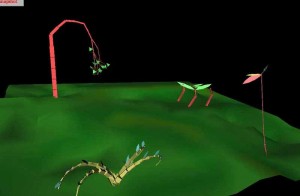
First version of Nerve Garden implemented in early 1997 as a preparation for the full SIGGRAPH Electric Garden version
The Nerves neural network engine, with its NerveScript language, underlies the entire informatic system of the work including rendering the garden visible and making it continually regenerative. Nerves is designed to transform the signals perceived by user interaction with the mouse, and stimulate growth interpreted by the specific modelization and visualization applications. It modifies the behavior of development of the plants and of the entire garden, ensuring the connection between them and the communication of information via the Internet. The long-term objective of the use of Nerves in the installation is to establish a new infrastructure, fundamental for the organization of shared virtual environments, capable of reflecting in the apparent exteriority of new living worlds their effective internal processes as happens in reality. Damer [describing the coming evolution of virtual environments in which behavior, not just representation, would be embodied — ANS] is in fact aware that “VRML 2.0 and other scene description languages can describe the appearance of a world. In nature, the outer appearance of plants and animals hides the more fundamental processes within. The protoplasm of plants and animals flows unseen, carrying control information, memory, fuel and other stimuli. A dense web of communication binds together all organisms, especially social animals… We are using Nerve Garden to test drive future versions of the Nerves engine and NerveScript. A successful proof of distributed neural network message processing within VRML 2.0 could enable Nerves to become a significant part of the ‘protoplasm of Cyberspace’.” Behaviors akin to the adaptive living matter and interactons within a virtual ecosystem are what Damer intends to achieve in the second version of Nerve Garden, making the “Nerves Engine” more faithful to the biological processes present in the animal nervous system and in the circulatory system of both plants and animals, so as to strengthen storage capacities and data flows.
The most immediate implication of the second version had therefore to be a greater interactive complexity between users and garden, including the possibility of watering or pruning the plants, as well as the inclusion of autonomous entities called ‘polyvores’, of virtual herbivores whose function would be to balance the ecosystem boosting the reproductive capacity of the plants and regulating their evolution [to “eat” polygons from plant models forcing the plants to adapt and regrow to sustain their ability to collect energy from artificial sunlight — ANS]. “In this virtual Tele-Garden,” conclude the authors, “users anywhere on the Internet with a capable VRML browser would be able to plant an L-System ‘seed’ and witness plant growth within a simple polygon/energy balanced ecology.”
As a work of net.art, the precedent of Nerve Garden can be identified in Tele-Garden by Ken Goldberg in 1995 [in which actual plants were seeded and tended robotically by multiple Internet users employing a camera and simple web interface — ANS]. Damer and the Biota.org group were moved in 1996 by an interest in recreating the Tele-Garden experience in an entirely digital world. For the second time in the vast world of the Internet a space is rendered and dedicated to cultivation and entrusted to virtual gardeners who would apply their “green cyber-thumbs” to cyber-organic Artificial Life. The relationship is no longer established with the organic dimension of familiar vegetable beings, of which one knows the vital functions and whose growth one regulates, but rather, with the characteristics of the inorganic Artificial Life that can generate plants within a virtual environment.
Compared with Tele-Garden which created an original way in which the practice of cultivation is realized for the users, operating at a distance via the Internet and by means of a robot, where the birth and the development of the plants are subjected to the natural biological cycle, and it is a question of real sown specimens in a real flowerbed, Nerve Garden, constructed entirely as artifice, becomes an “on line collaborative A-Life laboratory,” an experimental space allowing the users the possibility of getting closer to the mechanisms of the artificial living being by generating the plants themselves and determining the composition of the garden. Playing with the new biology and carrying out a sort of natural selection based on personal preference or maintaining the botanical species of reference or modifying the species creating individuals with different appearances, generating pseudo-organic vegetal imagery of their heart’s desire, a new life that evolves simulating the processes of natural growth.

The artist Bruce Damer on his farm in Northern California, with some of the fruits (and vegetables) of actual gardening
The landscape of multiple simulated islands receives, like a single open field, the actions of the unknown cyber-gardeners who find themselves operating together and wishing to contribute to giving a full face to the nature of the place. Favoring collective sharing and the curiousity of returning to check the development of one’s own plant or to compare with new neighboring starts by others, Nerve Garden does not so clearly create that feeling of community as is evident in Tele-Garden. Tele-Garden is designed to motivate exchanges and links among users; in Nerve Garden, the operations on the plant are limited to the definition of its appearance and to its planting in the ground (it retains its original shape without needing the constant attention of the user as a real vegetable would require); such operations are carried out individually, and it is not possible to act on what has previously been produced.
In Damer’s work, the creation of virtual vegetation is the fascinating element, almost a pretext, that captures the attention of the user and induces him to become a part of the construction of a new world: the objective of Nerve Garden extends to stimulating in the users the awareness of the capacity of software languages like VRML to develop three-dimensional spaces on the web, spaces of communication in which it is possible to use life-like algorithms to generate rather than construct the space. Nerve Garden II would be organized like an ecosystem in which, according to the intentions of the authors, would be active, next to the insects, the so-called polyvores, to the ecological benefit of the habitat, and the avatars, introduced to allow the users to feel even more immersed in the environment, thanks to the improvement of relationships and to a more direct control over the cultivation. What emerges is the use of the web as a space capable of hosting contexts parallel to the real world that often, as Nerve Garden demonstrates, do not aim to reflect or imitate the true reality, but which on the contrary prefer to show their difference from it. They emphasize the possibility of generating plants from bizarre forms, and features and colors similar to a comic book which delineate the panorama and the insects.
It is curious, in the specific case of Damer, to find that via the web one also reaches the real world of the artist: just as the site of the virtual garden of the work can be visited, the site of a natural garden created by him at Ancient Oaks farm, where he lives with his wife, Galen Brandt. Numerous images taken in different seasons show the various botanical typologies of trees, fruit trees, plants, and flowers that compose the garden, furnished with detailed descriptions: ample documentation that testifies to the special connection of Damer with nature, and his wish to enable the users of the Internet to participate in that reality. As the natural and the virtual interweave in the life of the artist, Damer makes them live together in the great “container” of the web.
Nerve Garden received recognition in the form of an honorable mention at Ars Electronica in 1998, and has been featured in numerous publications in both the sciences and the arts.
Ten years after Nerve Garden, Claude Lattaud led a team at the University of Paris V to create Darwin’s Park, which at long last realized the vision of Nerve Garden II. Darwin’s Park, a virtual environment in which L-System plants respond to light levels, moisture and minerals in the soil, and the local ecosystem of plants to create dynamic virtual garden environments. So in the end, the work of Damer and his colleagues seems to have struck a nerve, and generated promising and verdant follow-on projects.
